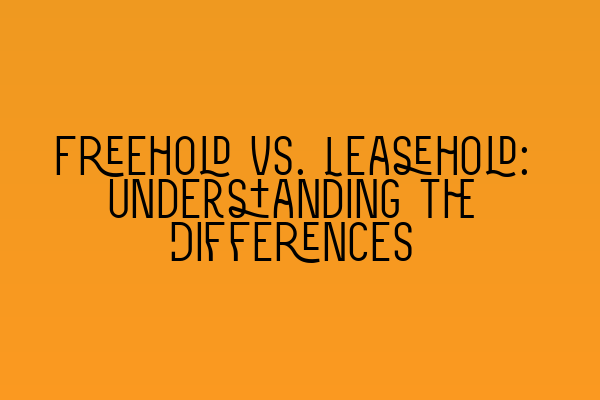In the world of property law, two common terms that often come up are “freehold” and “leasehold.” Understanding the differences between these two concepts is crucial, especially if you are buying or selling a property. In this blog post, we will dive deep into what freehold and leasehold mean, their characteristics, and the legal implications associated with each.
Freehold
Let’s start with freehold. In simple terms, freehold refers to absolute ownership of property, where you own the property and the land it stands on indefinitely. This means that you have complete control over the land and the buildings on it. Freehold properties are typically houses, bungalows, or flats where the ownership extends to the land as well.
One of the main advantages of owning a freehold property is that you have a greater sense of control and autonomy. You can make decisions about the property without seeking permission from anyone else. Additionally, freehold properties are generally more valuable and easier to sell, making them a popular choice for buyers.
However, owning a freehold property also means taking on all responsibilities and costs associated with maintaining the property. This includes repairs, renovations, and any other expenses that may arise. It’s important to keep this in mind when considering a freehold property, especially if you prefer a hands-off approach.
If you are interested in exploring further, you can check out our related article on SQE 1 Practice Exam Questions to test your knowledge about property law.
Leasehold
Now let’s turn our attention to leasehold properties. Unlike freehold, leasehold refers to a situation where you own a property for a certain period of time but not the land it stands on. When you purchase a leasehold property, you essentially enter into a lease agreement with the freeholder (the owner of the land) for a specific term, which is usually long-term such as 99 or 125 years.
Leasehold properties are commonly found in apartment buildings or developments with shared facilities. In these cases, the land is owned by a freeholder or a management company who grants long-term leases to individual owners. As a leaseholder, you have certain obligations and restrictions outlined in the lease agreement, such as paying ground rent and service charges for the maintenance of shared areas.
It’s important to carefully review the lease agreement before purchasing a leasehold property. The document will outline the terms and conditions governing your tenure, as well as any restrictions or covenants you must adhere to. Additionally, it’s worth considering the remaining length of the lease, as this can impact the property’s future value.
If you are preparing for your SQE exams and need some practice, you can take a look at our SQE 1 Practice Mocks FLK1 FLK2. These practice exams will help you familiarize yourself with property law concepts.
Key Differences
Now that we have a clear understanding of what freehold and leasehold mean, let’s summarize the key differences between the two:
- Ownership: Freehold provides full ownership of both the property and the land, whereas leasehold only grants ownership of the property for a fixed term.
- Responsibilities: Freehold property owners bear full responsibility for maintenance and repairs, while leaseholders contribute to the costs through ground rent and service charges.
- Control: Freehold property owners have more control over the property, making decisions without seeking permission, whereas leaseholders must adhere to the terms outlined in the lease agreement and seek consent for certain actions.
- Value: Freehold properties generally hold their value better than leasehold properties as the lease term decreases over time.
If you are looking for comprehensive preparation resources for your SQE exams, check out our SQE 2 Preparation Courses and SQE 1 Preparation Courses. These courses are designed to help you excel in your studies and perform well on your exams.
Lastly, if you’re curious about upcoming SRA SQE exam dates, take a look at our article on SRA SQE Exam Dates to stay informed and plan your study schedule accordingly.
Understanding the differences between freehold and leasehold is essential when making property-related decisions. Whether you’re buying, selling, or studying property law, having a solid grasp of these concepts will serve you well.
